Predictors of inguinal lymph node metastasis in penile cancer patients: a meta-analysis of retrospective studies
- PMID: 31372046
- PMCID: PMC6628149
- DOI: 10.2147/CMAR.S206579
Predictors of inguinal lymph node metastasis in penile cancer patients: a meta-analysis of retrospective studies
Abstract
Purpose: Inguinal lymph node metastasis (LNM) is one of the most significant prognostic factors for patients with penile cancer. This study aimed to identify potential predictors of inguinal LNM.
Patients and methods: A comprehensive search of the PubMed, Embase, and Cochrane Library databases for studies that reported predictors of inguinal LNM in penile cancer was performed. Finally, we selected 42 eligible studies with 4,802 patients. Accumulative analyses of odds ratios (ORs) and corresponding 95% confidence intervals (CIs) were performed. All analyses were performed by using Review Manager software version 5.3.
Results: Among the 4,802 patients, 1,706 (36%) were diagnosed with inguinal LNM. Predictors of LNM included two categories: tumor-associated biomarkers and invasive clinicopathologic characteristics. Biomarker-specific predictors: the program death ligand 1 (PD-L1) overexpression (OR=2.55, p=0.002), higher neutrophil-to-lymphocyte ratio (NLR) (OR=4.22, p=0.010), higher C-reactive protein (CRP) (OR=4.78, p<0.001), squamous cell carcinoma antigen (SCC-Ag) overexpression (OR=8.52, p<0.001), P53 protein overexpression (OR=3.57, p<0.001). Clinicopathological predictors: positive clinical lymph node (cN+) (OR=5.86, p<0.001), high-risk histopathological subtype (OR=14.63, p<0.001) and intermediate-risk subtype (OR=3.37, p<0.001), vertical growth pattern (OR=1.97, p=0.020), higher stage (AJCC: OR=3.66, p<0.001; UICC: OR=2.43, p<0.001), higher tumor grade (OR=3.37, p<0.001), tumor size (>3 cm) (OR=2.00, p=0.002), LVI (OR=3.37, p<0.001), invasion depth (>5 mm) (OR=2.58, p=0.002), nerve invasion (OR=2.84, p<0.001), corpora cavernosum invasion (OR=2.22, p<0.001), corpus spongiosum invasion (OR=1.73, p=0.002) and urethra invasion (OR=1.81, p=0.030).
Conclusion: Current meta-analysis conclusively identified valuable predictors of inguinal LNM for patients with penile cancer. However, high-quality studies are warranted to further validate our conclusions. The intrinsic link between these predictors needs to be further investigated to create an accurate mathematical prediction model for LNM.
Keywords: inguinal lymph node metastasis; meta-analysis; penile cancer; predictor.
Conflict of interest statement
The authors report no conflicts of interest in this work.
Figures

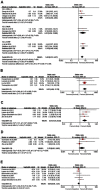

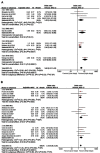
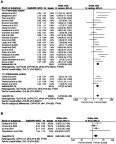
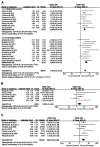
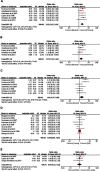
Similar articles
-
Corpora Cavernos invasion vs. Corpus Spongiosum invasion in Penile Cancer: A systematic review and meta-analysis.J Cancer. 2021 Jan 30;12(7):1960-1966. doi: 10.7150/jca.56504. eCollection 2021. J Cancer. 2021. PMID: 33753994 Free PMC article.
-
A nomogram incorporating PD-L1, NLR, and clinicopathologic features to predict inguinal lymph node metastasis in penile squamous cell carcinoma.Urol Oncol. 2020 Jul;38(7):641.e19-641.e29. doi: 10.1016/j.urolonc.2020.04.015. Epub 2020 May 7. Urol Oncol. 2020. PMID: 32389428
-
The risk factors for the presence of pelvic lymph node metastasis in penile squamous cell carcinoma patients with inguinal lymph node dissection.World J Urol. 2013 Dec;31(6):1519-24. doi: 10.1007/s00345-013-1024-4. Epub 2013 Feb 28. World J Urol. 2013. PMID: 23455885
-
Diagnosis and staging of penile cancer.Urology. 2010 Aug;76(2 Suppl 1):S15-23. doi: 10.1016/j.urology.2010.03.002. Urology. 2010. PMID: 20691881 Review.
-
Is There an Oncological Benefit of Performing Bilateral Pelvic Lymph Node Dissection in Patients with Penile Cancer and Inguinal Lymph Node Metastasis?J Clin Med. 2021 Feb 13;10(4):754. doi: 10.3390/jcm10040754. J Clin Med. 2021. PMID: 33668548 Free PMC article. Review.
Cited by
-
Corpora Cavernos invasion vs. Corpus Spongiosum invasion in Penile Cancer: A systematic review and meta-analysis.J Cancer. 2021 Jan 30;12(7):1960-1966. doi: 10.7150/jca.56504. eCollection 2021. J Cancer. 2021. PMID: 33753994 Free PMC article.
-
Predict Lymph Node Metastasis in Penile Cancer Using Clinicopathological Factors and Nomograms.Cancer Manag Res. 2021 Sep 24;13:7429-7437. doi: 10.2147/CMAR.S329925. eCollection 2021. Cancer Manag Res. 2021. PMID: 34594135 Free PMC article.
-
Predictive histopathological factors of nodal metastasis in penile cancer.Int Braz J Urol. 2023 Sep-Oct;49(5):628-636. doi: 10.1590/S1677-5538.IBJU.2022.0640. Int Braz J Urol. 2023. PMID: 37351908 Free PMC article. No abstract available.
-
Molecular stratification by BCL2A1 and AIM2 provides additional prognostic value in penile squamous cell carcinoma.Theranostics. 2021 Jan 1;11(3):1364-1376. doi: 10.7150/thno.51725. eCollection 2021. Theranostics. 2021. PMID: 33391539 Free PMC article.
-
Factors predictive of recurrence, metastasis and death in node-negative penile squamous cell carcinoma: A retrospective multicentre cohort study.J Eur Acad Dermatol Venereol. 2025 Mar;39(3):576-585. doi: 10.1111/jdv.20093. Epub 2024 Jun 6. J Eur Acad Dermatol Venereol. 2025. PMID: 38842227
References
LinkOut - more resources
Full Text Sources
Research Materials
Miscellaneous

